Data Analysis: Calculating Mean, Median, and Forecasting Models
VerifiedAdded on 2023/01/11
|9
|1322
|73
Homework Assignment
AI Summary
This assignment delves into the practical application of numeracy and data analysis techniques. It begins with the organization of data in a tabular format, followed by its representation through various chart forms, facilitating a visual understanding of the data trends. The core of the assignment involves calculating key statistical terms, including the mean, median, mode, range, and standard deviation, providing a comprehensive understanding of data distribution and central tendencies. Furthermore, the assignment explores the application of a linear forecasting model, enabling the prediction of future values based on historical data. This includes a step-by-step calculation of the model's parameters (m and c) and the subsequent forecasting of values for specific time points. The conclusion emphasizes the importance of data analysis in drawing informed insights and making strategic decisions, highlighting the practical applications of these techniques in various business contexts. The assignment uses a dataset of sleeping hours over ten consecutive days to illustrate these concepts, providing a tangible example of how these methods can be applied.
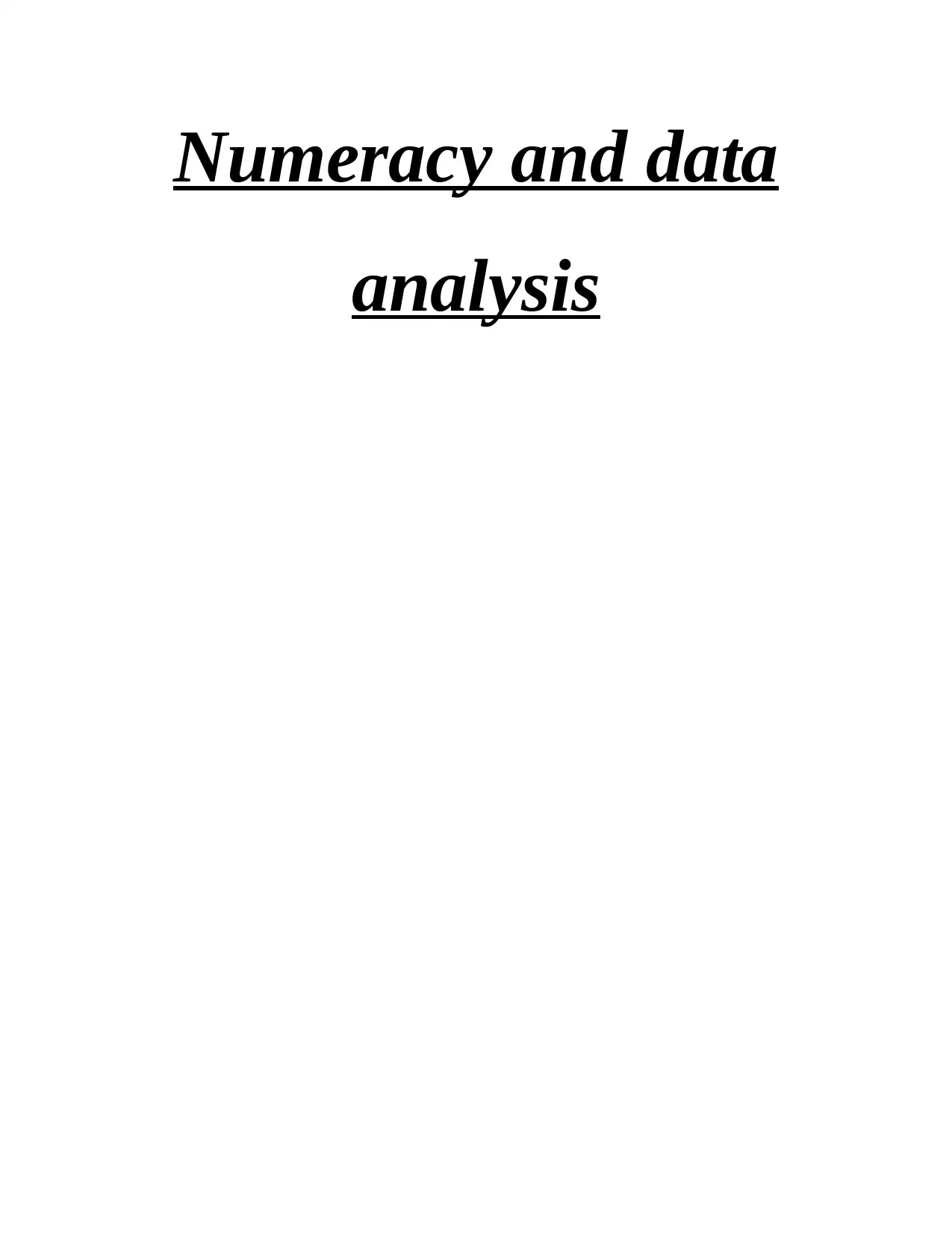
Numeracy and data
analysis
analysis
Paraphrase This Document
Need a fresh take? Get an instant paraphrase of this document with our AI Paraphraser
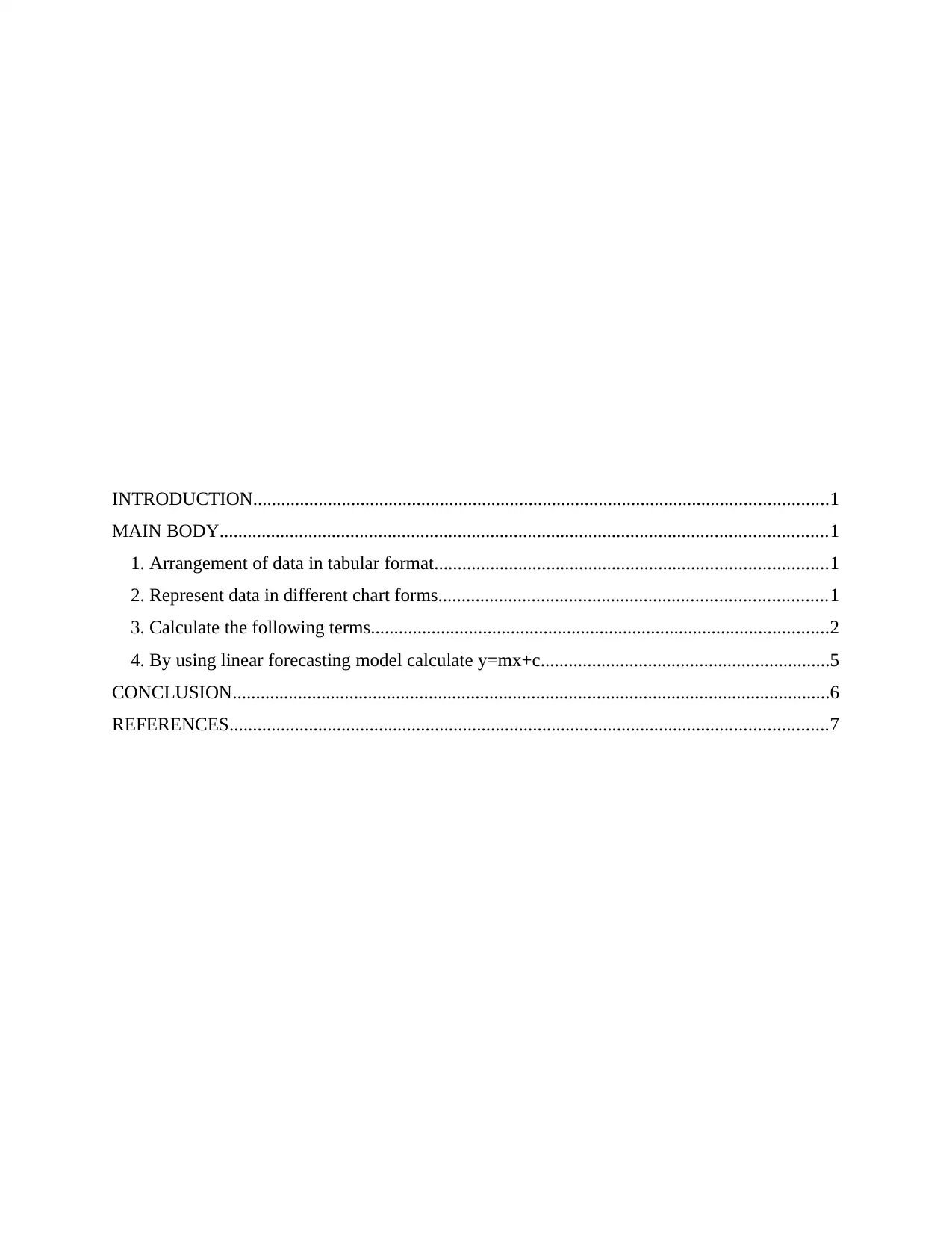
INTRODUCTION...........................................................................................................................1
MAIN BODY..................................................................................................................................1
1. Arrangement of data in tabular format....................................................................................1
2. Represent data in different chart forms...................................................................................1
3. Calculate the following terms..................................................................................................2
4. By using linear forecasting model calculate y=mx+c..............................................................5
CONCLUSION................................................................................................................................6
REFERENCES................................................................................................................................7
MAIN BODY..................................................................................................................................1
1. Arrangement of data in tabular format....................................................................................1
2. Represent data in different chart forms...................................................................................1
3. Calculate the following terms..................................................................................................2
4. By using linear forecasting model calculate y=mx+c..............................................................5
CONCLUSION................................................................................................................................6
REFERENCES................................................................................................................................7

INTRODUCTION
Numeracy and data analysis is a data gathering and manipulation process which helps
companies to enhance valuable knowledge (Dowding, and Et.al., 2018). This lets researchers
or managers devise plans as per the necessity to increase the overall performance. In other
words, the primary aim of data processing is to determine what knowledge depends on
interpretation that may be essential. The work focuses mainly on data collection, in which data is
linked to ten consecutive days that is based on the sleeping hours. The project report also
contains a significant range of metrics such as mean, step, average, and forecasts.
MAIN BODY
1. Arrangement of data in tabular format
Below mention data represent the sleeping pattern of an individual for ten consecutive
days. These data mentioned in the tabular form for the purpose of analysing various term.
Days Sleeping
Hours
1 12
2 5
3 12
4 15
5 9
6 12
7 8
8 7
9 10
10 15
2. Represent data in different chart forms
Below mention charts are the graphical representation which helps the people to
understand the trend of available data (Geiger, 2018). With the help of bar or column chart,
people able to evaluate that in which day sleeping hours are maximum or minimum.
Bar Chart:
1
Numeracy and data analysis is a data gathering and manipulation process which helps
companies to enhance valuable knowledge (Dowding, and Et.al., 2018). This lets researchers
or managers devise plans as per the necessity to increase the overall performance. In other
words, the primary aim of data processing is to determine what knowledge depends on
interpretation that may be essential. The work focuses mainly on data collection, in which data is
linked to ten consecutive days that is based on the sleeping hours. The project report also
contains a significant range of metrics such as mean, step, average, and forecasts.
MAIN BODY
1. Arrangement of data in tabular format
Below mention data represent the sleeping pattern of an individual for ten consecutive
days. These data mentioned in the tabular form for the purpose of analysing various term.
Days Sleeping
Hours
1 12
2 5
3 12
4 15
5 9
6 12
7 8
8 7
9 10
10 15
2. Represent data in different chart forms
Below mention charts are the graphical representation which helps the people to
understand the trend of available data (Geiger, 2018). With the help of bar or column chart,
people able to evaluate that in which day sleeping hours are maximum or minimum.
Bar Chart:
1
⊘ This is a preview!⊘
Do you want full access?
Subscribe today to unlock all pages.

Trusted by 1+ million students worldwide
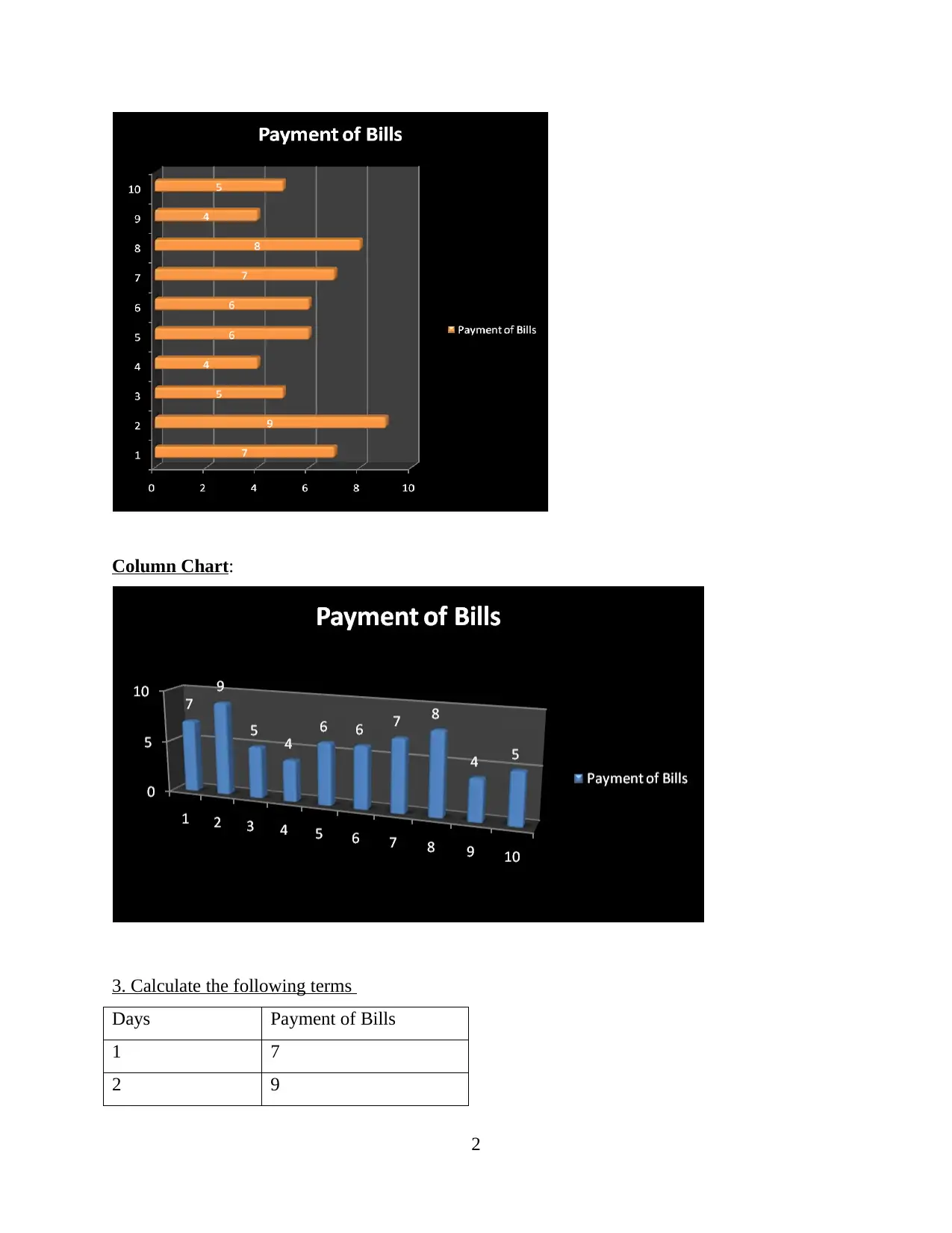
Column Chart:
3. Calculate the following terms
Days Payment of Bills
1 7
2 9
2
3. Calculate the following terms
Days Payment of Bills
1 7
2 9
2
Paraphrase This Document
Need a fresh take? Get an instant paraphrase of this document with our AI Paraphraser
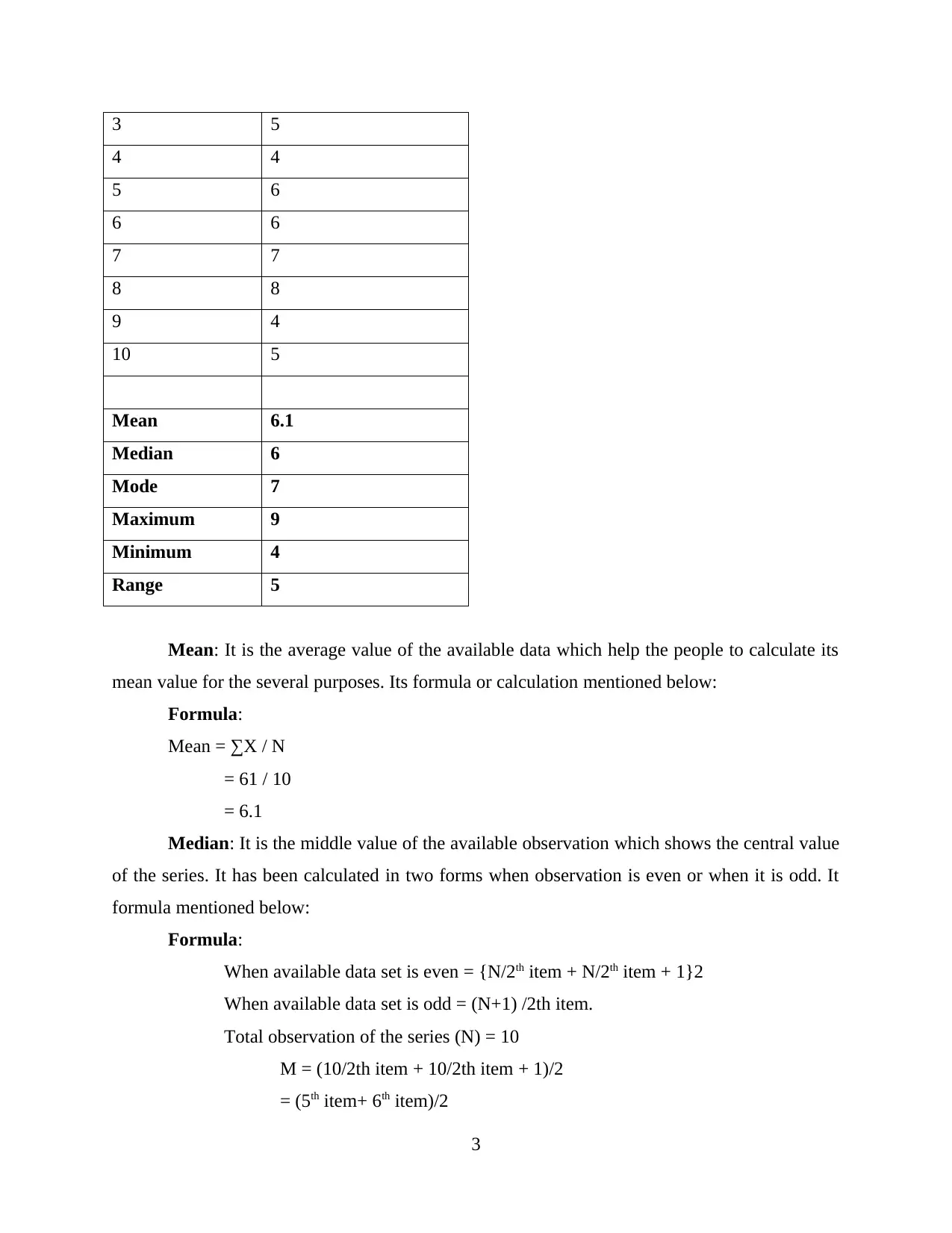
3 5
4 4
5 6
6 6
7 7
8 8
9 4
10 5
Mean 6.1
Median 6
Mode 7
Maximum 9
Minimum 4
Range 5
Mean: It is the average value of the available data which help the people to calculate its
mean value for the several purposes. Its formula or calculation mentioned below:
Formula:
Mean = ∑X / N
= 61 / 10
= 6.1
Median: It is the middle value of the available observation which shows the central value
of the series. It has been calculated in two forms when observation is even or when it is odd. It
formula mentioned below:
Formula:
When available data set is even = {N/2th item + N/2th item + 1}2
When available data set is odd = (N+1) /2th item.
Total observation of the series (N) = 10
M = (10/2th item + 10/2th item + 1)/2
= (5th item+ 6th item)/2
3
4 4
5 6
6 6
7 7
8 8
9 4
10 5
Mean 6.1
Median 6
Mode 7
Maximum 9
Minimum 4
Range 5
Mean: It is the average value of the available data which help the people to calculate its
mean value for the several purposes. Its formula or calculation mentioned below:
Formula:
Mean = ∑X / N
= 61 / 10
= 6.1
Median: It is the middle value of the available observation which shows the central value
of the series. It has been calculated in two forms when observation is even or when it is odd. It
formula mentioned below:
Formula:
When available data set is even = {N/2th item + N/2th item + 1}2
When available data set is odd = (N+1) /2th item.
Total observation of the series (N) = 10
M = (10/2th item + 10/2th item + 1)/2
= (5th item+ 6th item)/2
3
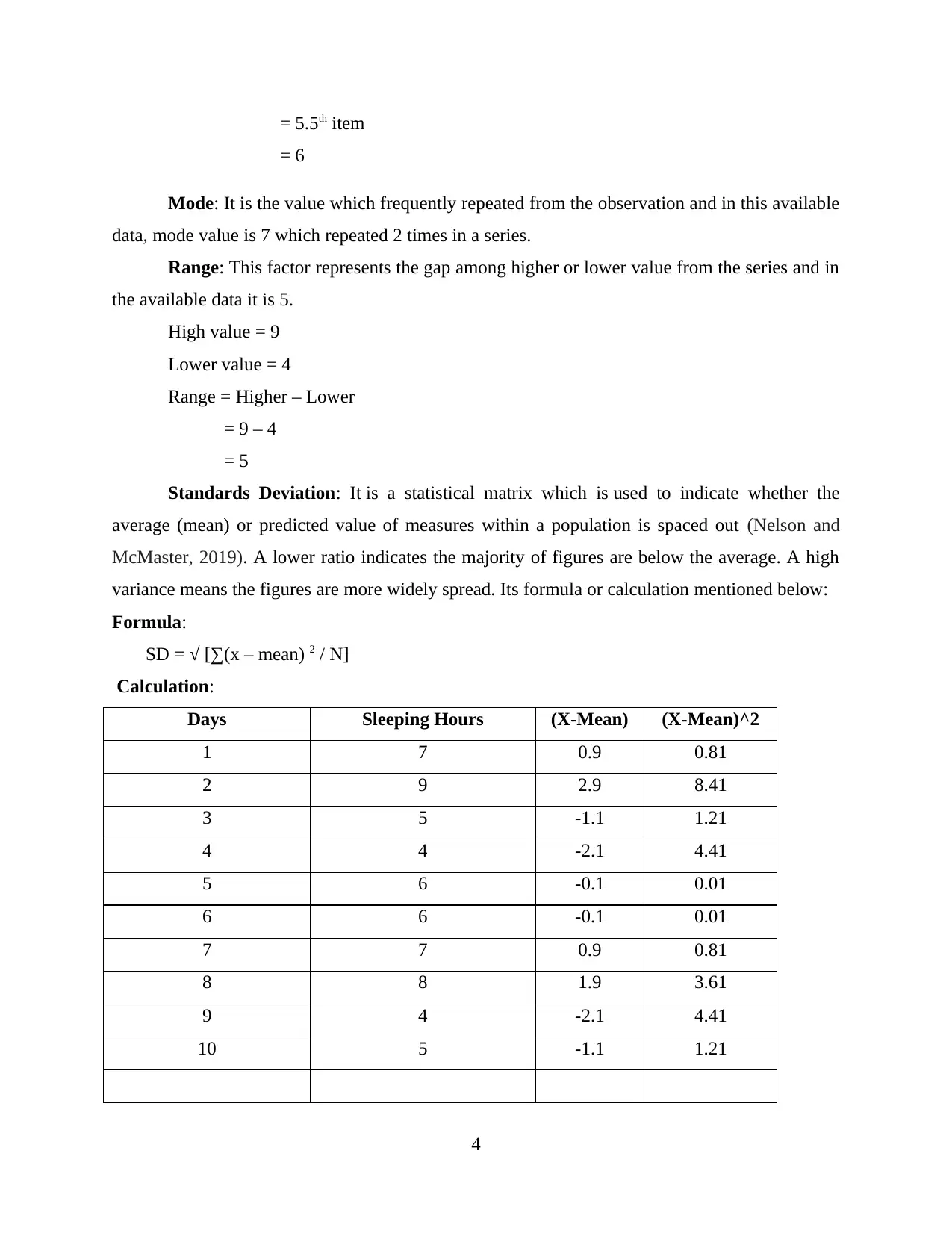
= 5.5th item
= 6
Mode: It is the value which frequently repeated from the observation and in this available
data, mode value is 7 which repeated 2 times in a series.
Range: This factor represents the gap among higher or lower value from the series and in
the available data it is 5.
High value = 9
Lower value = 4
Range = Higher – Lower
= 9 – 4
= 5
Standards Deviation: It is a statistical matrix which is used to indicate whether the
average (mean) or predicted value of measures within a population is spaced out (Nelson and
McMaster, 2019). A lower ratio indicates the majority of figures are below the average. A high
variance means the figures are more widely spread. Its formula or calculation mentioned below:
Formula:
SD = √ [∑(x – mean) 2 / N]
Calculation:
Days Sleeping Hours (X-Mean) (X-Mean)^2
1 7 0.9 0.81
2 9 2.9 8.41
3 5 -1.1 1.21
4 4 -2.1 4.41
5 6 -0.1 0.01
6 6 -0.1 0.01
7 7 0.9 0.81
8 8 1.9 3.61
9 4 -2.1 4.41
10 5 -1.1 1.21
4
= 6
Mode: It is the value which frequently repeated from the observation and in this available
data, mode value is 7 which repeated 2 times in a series.
Range: This factor represents the gap among higher or lower value from the series and in
the available data it is 5.
High value = 9
Lower value = 4
Range = Higher – Lower
= 9 – 4
= 5
Standards Deviation: It is a statistical matrix which is used to indicate whether the
average (mean) or predicted value of measures within a population is spaced out (Nelson and
McMaster, 2019). A lower ratio indicates the majority of figures are below the average. A high
variance means the figures are more widely spread. Its formula or calculation mentioned below:
Formula:
SD = √ [∑(x – mean) 2 / N]
Calculation:
Days Sleeping Hours (X-Mean) (X-Mean)^2
1 7 0.9 0.81
2 9 2.9 8.41
3 5 -1.1 1.21
4 4 -2.1 4.41
5 6 -0.1 0.01
6 6 -0.1 0.01
7 7 0.9 0.81
8 8 1.9 3.61
9 4 -2.1 4.41
10 5 -1.1 1.21
4
⊘ This is a preview!⊘
Do you want full access?
Subscribe today to unlock all pages.

Trusted by 1+ million students worldwide
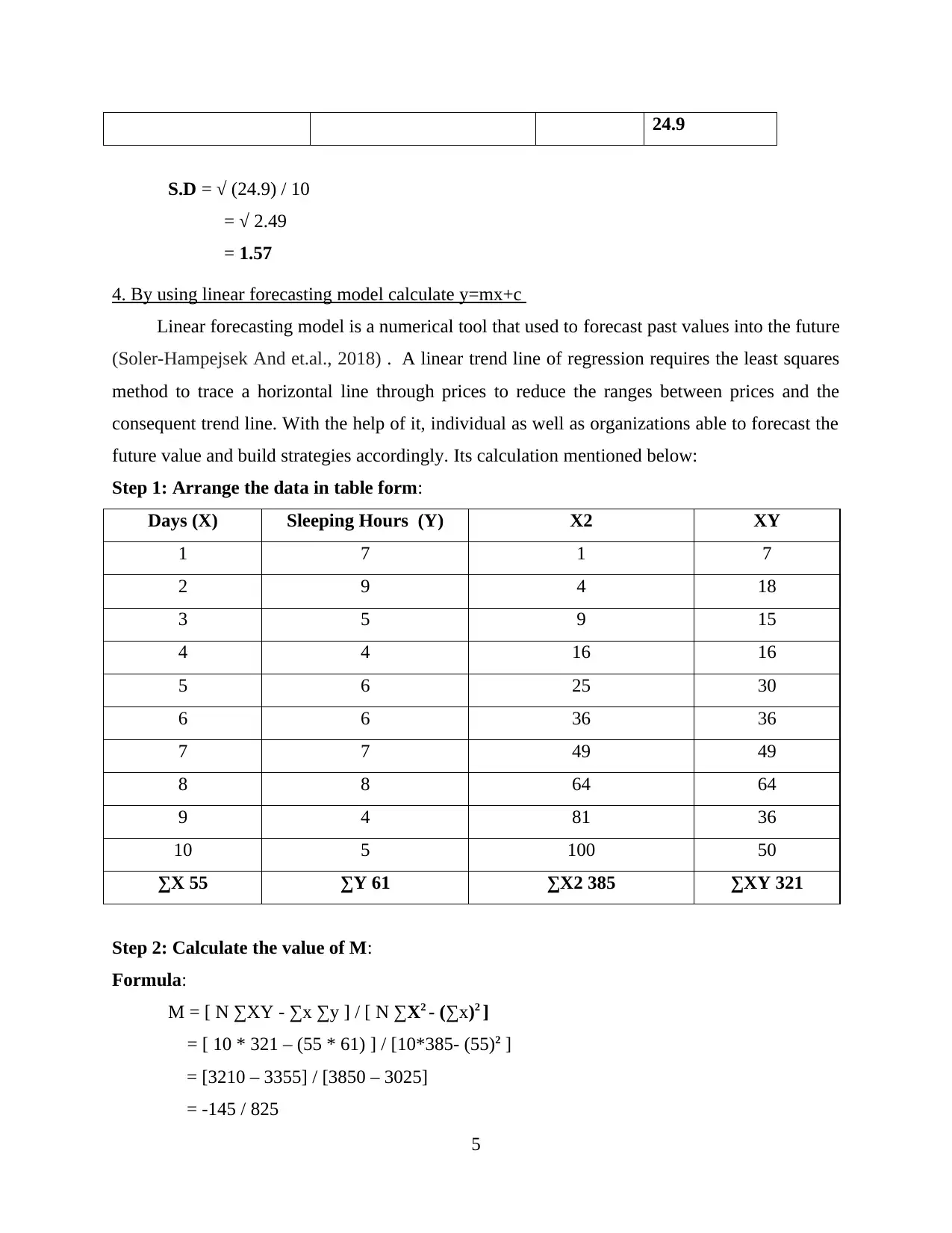
24.9
S.D = √ (24.9) / 10
= √ 2.49
= 1.57
4. By using linear forecasting model calculate y=mx+c
Linear forecasting model is a numerical tool that used to forecast past values into the future
(Soler-Hampejsek And et.al., 2018) . A linear trend line of regression requires the least squares
method to trace a horizontal line through prices to reduce the ranges between prices and the
consequent trend line. With the help of it, individual as well as organizations able to forecast the
future value and build strategies accordingly. Its calculation mentioned below:
Step 1: Arrange the data in table form:
Days (X) Sleeping Hours (Y) X2 XY
1 7 1 7
2 9 4 18
3 5 9 15
4 4 16 16
5 6 25 30
6 6 36 36
7 7 49 49
8 8 64 64
9 4 81 36
10 5 100 50
∑X 55 ∑Y 61 ∑X2 385 ∑XY 321
Step 2: Calculate the value of M:
Formula:
M = [ N ∑XY - ∑x ∑y ] / [ N ∑X2 - (∑x)2 ]
= [ 10 * 321 – (55 * 61) ] / [10*385- (55)2 ]
= [3210 – 3355] / [3850 – 3025]
= -145 / 825
5
S.D = √ (24.9) / 10
= √ 2.49
= 1.57
4. By using linear forecasting model calculate y=mx+c
Linear forecasting model is a numerical tool that used to forecast past values into the future
(Soler-Hampejsek And et.al., 2018) . A linear trend line of regression requires the least squares
method to trace a horizontal line through prices to reduce the ranges between prices and the
consequent trend line. With the help of it, individual as well as organizations able to forecast the
future value and build strategies accordingly. Its calculation mentioned below:
Step 1: Arrange the data in table form:
Days (X) Sleeping Hours (Y) X2 XY
1 7 1 7
2 9 4 18
3 5 9 15
4 4 16 16
5 6 25 30
6 6 36 36
7 7 49 49
8 8 64 64
9 4 81 36
10 5 100 50
∑X 55 ∑Y 61 ∑X2 385 ∑XY 321
Step 2: Calculate the value of M:
Formula:
M = [ N ∑XY - ∑x ∑y ] / [ N ∑X2 - (∑x)2 ]
= [ 10 * 321 – (55 * 61) ] / [10*385- (55)2 ]
= [3210 – 3355] / [3850 – 3025]
= -145 / 825
5
Paraphrase This Document
Need a fresh take? Get an instant paraphrase of this document with our AI Paraphraser
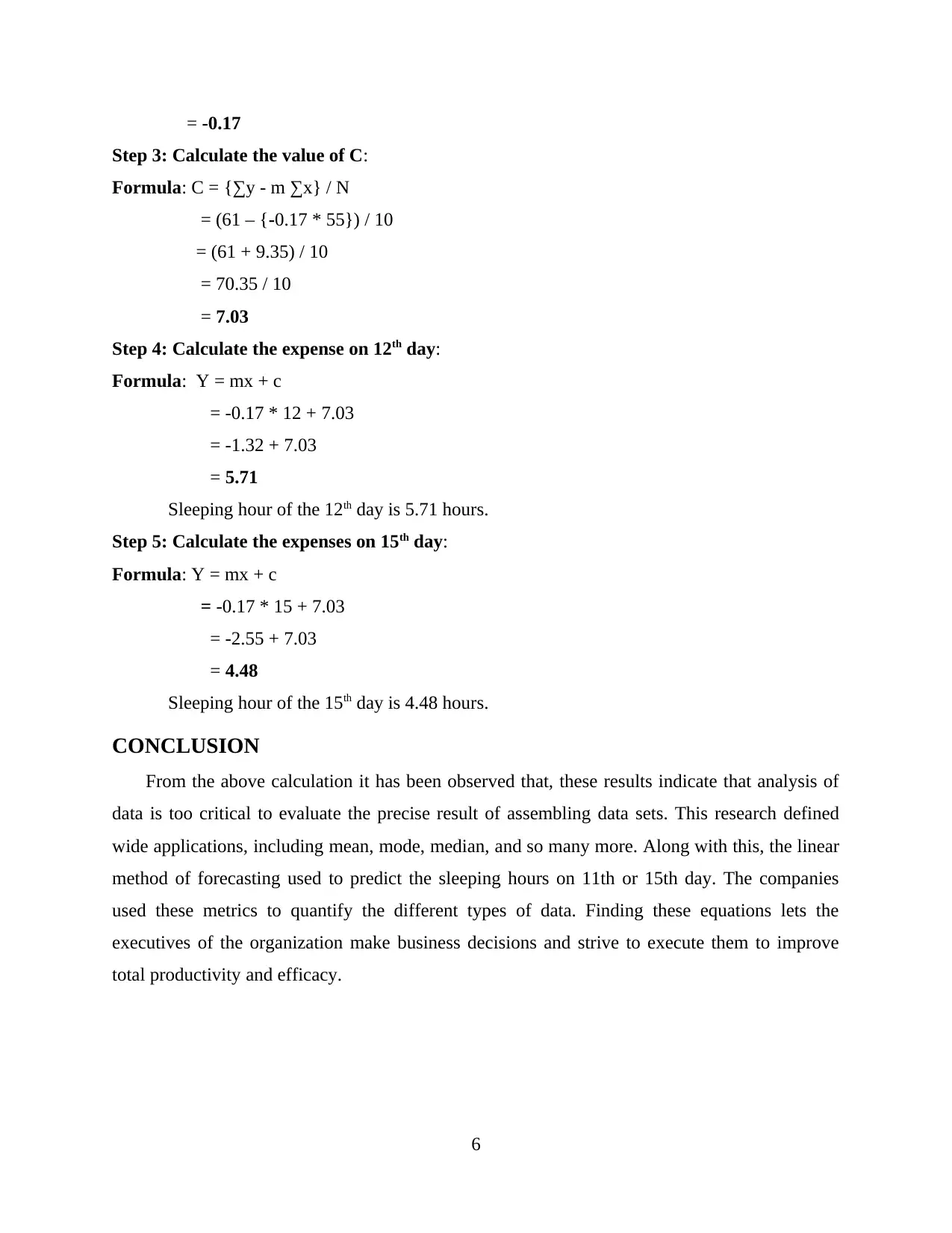
= -0.17
Step 3: Calculate the value of C:
Formula: C = {∑y - m ∑x} / N
= (61 – {-0.17 * 55}) / 10
= (61 + 9.35) / 10
= 70.35 / 10
= 7.03
Step 4: Calculate the expense on 12th day:
Formula: Y = mx + c
= -0.17 * 12 + 7.03
= -1.32 + 7.03
= 5.71
Sleeping hour of the 12th day is 5.71 hours.
Step 5: Calculate the expenses on 15th day:
Formula: Y = mx + c
= -0.17 * 15 + 7.03
= -2.55 + 7.03
= 4.48
Sleeping hour of the 15th day is 4.48 hours.
CONCLUSION
From the above calculation it has been observed that, these results indicate that analysis of
data is too critical to evaluate the precise result of assembling data sets. This research defined
wide applications, including mean, mode, median, and so many more. Along with this, the linear
method of forecasting used to predict the sleeping hours on 11th or 15th day. The companies
used these metrics to quantify the different types of data. Finding these equations lets the
executives of the organization make business decisions and strive to execute them to improve
total productivity and efficacy.
6
Step 3: Calculate the value of C:
Formula: C = {∑y - m ∑x} / N
= (61 – {-0.17 * 55}) / 10
= (61 + 9.35) / 10
= 70.35 / 10
= 7.03
Step 4: Calculate the expense on 12th day:
Formula: Y = mx + c
= -0.17 * 12 + 7.03
= -1.32 + 7.03
= 5.71
Sleeping hour of the 12th day is 5.71 hours.
Step 5: Calculate the expenses on 15th day:
Formula: Y = mx + c
= -0.17 * 15 + 7.03
= -2.55 + 7.03
= 4.48
Sleeping hour of the 15th day is 4.48 hours.
CONCLUSION
From the above calculation it has been observed that, these results indicate that analysis of
data is too critical to evaluate the precise result of assembling data sets. This research defined
wide applications, including mean, mode, median, and so many more. Along with this, the linear
method of forecasting used to predict the sleeping hours on 11th or 15th day. The companies
used these metrics to quantify the different types of data. Finding these equations lets the
executives of the organization make business decisions and strive to execute them to improve
total productivity and efficacy.
6
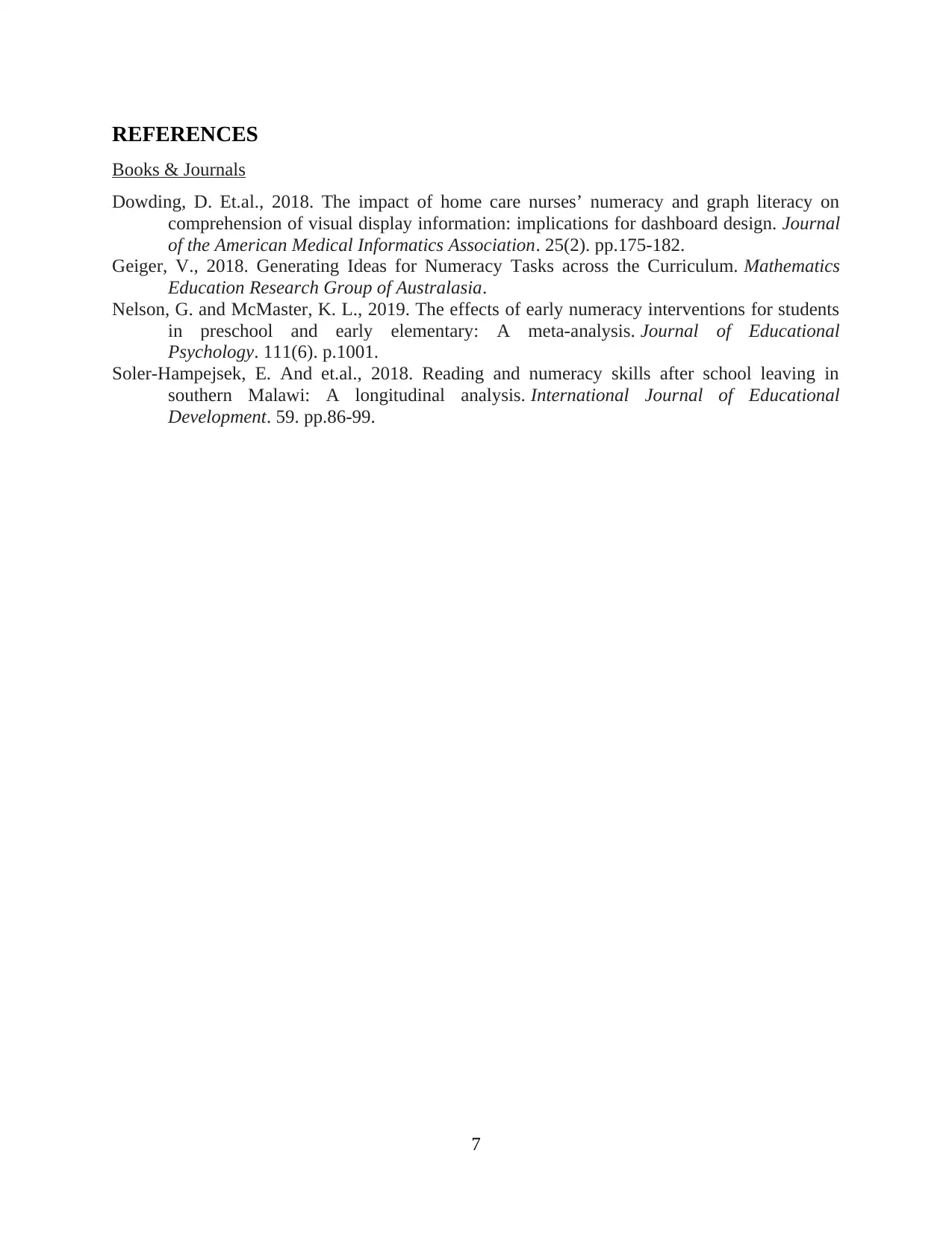
REFERENCES
Books & Journals
Dowding, D. Et.al., 2018. The impact of home care nurses’ numeracy and graph literacy on
comprehension of visual display information: implications for dashboard design. Journal
of the American Medical Informatics Association. 25(2). pp.175-182.
Geiger, V., 2018. Generating Ideas for Numeracy Tasks across the Curriculum. Mathematics
Education Research Group of Australasia.
Nelson, G. and McMaster, K. L., 2019. The effects of early numeracy interventions for students
in preschool and early elementary: A meta-analysis. Journal of Educational
Psychology. 111(6). p.1001.
Soler-Hampejsek, E. And et.al., 2018. Reading and numeracy skills after school leaving in
southern Malawi: A longitudinal analysis. International Journal of Educational
Development. 59. pp.86-99.
7
Books & Journals
Dowding, D. Et.al., 2018. The impact of home care nurses’ numeracy and graph literacy on
comprehension of visual display information: implications for dashboard design. Journal
of the American Medical Informatics Association. 25(2). pp.175-182.
Geiger, V., 2018. Generating Ideas for Numeracy Tasks across the Curriculum. Mathematics
Education Research Group of Australasia.
Nelson, G. and McMaster, K. L., 2019. The effects of early numeracy interventions for students
in preschool and early elementary: A meta-analysis. Journal of Educational
Psychology. 111(6). p.1001.
Soler-Hampejsek, E. And et.al., 2018. Reading and numeracy skills after school leaving in
southern Malawi: A longitudinal analysis. International Journal of Educational
Development. 59. pp.86-99.
7
⊘ This is a preview!⊘
Do you want full access?
Subscribe today to unlock all pages.

Trusted by 1+ million students worldwide
1 out of 9
Related Documents
Your All-in-One AI-Powered Toolkit for Academic Success.
+13062052269
info@desklib.com
Available 24*7 on WhatsApp / Email
![[object Object]](/_next/static/media/star-bottom.7253800d.svg)
Unlock your academic potential
Copyright © 2020–2025 A2Z Services. All Rights Reserved. Developed and managed by ZUCOL.
![Data Analysis and Numeracy Assignment Solution - [Course Name]](/_next/image/?url=https%3A%2F%2Fdesklib.com%2Fmedia%2Fimages%2Fsi%2Fa7d85ae2b1bb4280b388902c677b7f7e.jpg&w=256&q=75)




